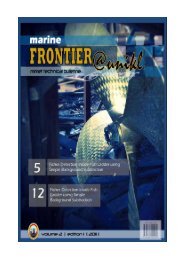click here to download - UniKL MIMET Official Website
click here to download - UniKL MIMET Official Website
click here to download - UniKL MIMET Official Website
You also want an ePaper? Increase the reach of your titles
YUMPU automatically turns print PDFs into web optimized ePapers that Google loves.
Preparation and procedure for Mechanical<br />
Properties Testing<br />
Tensile test are carried out at a crosshead<br />
speed of 1.0 mm/min at room temperature. The<br />
ultimate strength and location of fracture are<br />
determined. The fractured surfaces are analyzed<br />
by X‐ray diffrac<strong>to</strong>meter using Cu‐k radiation.<br />
Fractured surfaces are observed by Scanning<br />
Electron Microscope (SEM) and frac<strong>to</strong>graphs ex‐<br />
amined. SEM pho<strong>to</strong>graphs of these interface<br />
fractured specimens are also taken.<br />
The metallographic specimens are also used<br />
for hardness testing. In this test, the microhard‐<br />
ness tester of the Vickers hardness testing ma‐<br />
chine is employed with loads of 5 and 10 grams.<br />
The hardness is measured across the bonding<br />
interface.<br />
BENEFITS OF DIFFUSION BONDING/ WELDING<br />
The diffusion bonding process is normally used<br />
<strong>to</strong> fabricate parts, when highly‐quality and high‐<br />
strength welds are required, w<strong>here</strong> part shapes<br />
are intricate and would be costly or impossible<br />
<strong>to</strong> manufacture by conventional means or when<br />
the materials used possess unique properties<br />
that interfere with, or area difficult <strong>to</strong> maintain<br />
during conventional fabrication processing. This<br />
specialized welding process has found consider‐<br />
able acceptance in the manufacturing of aero‐<br />
space, nuclear and electronics components.<br />
Further research of this concept would be<br />
beneficial at University level as it will focus on<br />
the development and validation of new joining<br />
techniques specifically for the dissimilar materi‐<br />
als such as between steel and aluminum alloy.<br />
The potential success of a possible research will<br />
contribute enormously <strong>to</strong> the development of a<br />
new welding technology and scientific knowl‐<br />
edge <strong>to</strong> the university and as an alternative fab‐<br />
rication and production methods in the marine<br />
and other related industries. Joining of alumin‐<br />
<strong>MIMET</strong> Technical Bulletin Volume 1 (2) 2010<br />
ium superstructure <strong>to</strong> steel deck and aluminium<br />
decks (or even bulkheads) <strong>to</strong> steel hulls and<br />
other ship’s components fabrication, fitting and<br />
mounting are examples of possibility of utilizing<br />
diffusion bonding technique in marine construc‐<br />
tion.<br />
CONCLUSION AND RECOMMENDATION<br />
Realizing the important and benefits of the diffu‐<br />
sion bonding/ welding as mentioned above, it is<br />
recommended that further research <strong>to</strong> be con‐<br />
ducted at <strong>UniKL</strong> <strong>MIMET</strong> that would benefit the aca‐<br />
demic fraternity in particular and the related indus‐<br />
tries in general.<br />
REFERENCES<br />
1.AWS. 1938. “The AWS Master Chart of Welding Process”.<br />
AWS Welding Handbook American Welding Society, Miami,<br />
Florida<br />
2.D.F. Paulonis, “Diffusion Welding and Brazing”, Pratt and<br />
Whitney Aircraft Group, United Technologies, USA.<br />
3. D.F. Paulonis, “Advanced Diffusion Welding Process”, Pratt<br />
and Whitney Aircraft Group, United Technologies, USA.<br />
4.Tadashi Momono, 1990. “Diffusion Bonding of Cast Iron <strong>to</strong><br />
Steel under Atmospheric Pressure”, Casting Science and Tech‐<br />
nology, The Japan Foundrymen Society, Japan.<br />
| MARINE FRONTIER @ <strong>UniKL</strong><br />
73



